11 November, 2003
Happy Camper School!
Temperature: 16*F
Location: Sea Ice near McMurdo Station, Antarctica
What a day! Peter and I had a class this morning on waste management.
This class went over the extensive recycling program in Antarctica,
procedures for reporting and cleaning any spills - oil/gas, and how to
help preserve and protect the natural beauty of Antarctica. There are
very strict rules and regulations that everyone must follow. I can't
help but wonder what the world would be like if everyone in every
location followed the same guidelines that are in place in Antarctica.
After our class, Peter met up with Phil and Roman to head out to the Dry
Valleys. I went over to Field Training School - more commonly know as
"happy camper school." This is a mandatory class for anyone who is
traveling to locations which are distant from McMurdo. The purpose of
the class is to teach everyone how to stay as safe as possible in the
Antarctic environment.
We reviewed natural and human imposed risk factors such as crevasses,
weather, helicopters, and other types of machinery that are commonly
used in Antarctica. The best way to stay safe is to be prepared; know
what the risks in the area are, and focus on preventing problems of any
kind. In Antarctica, even the simplest problem can escalate into
something bigger if not responded to properly.
Perhaps one of the biggest weather related risks is hypothermia. There
are three stages to hypothermia: mild, moderate, and severe. Knowing
how to prevent, and recognizing symptoms of, hypothermia can make for a
much more pleasant experience here on "the Ice." The symptoms are the
same everywhere, so everyone would benefit from knowing how to prevent
and treat hypothermia.
Hypothermia is a body temperature problem; the person's body temperature
is lowering to levels that are below normal.
The first symptoms are "the umbles" and mild shivering. A person
suffering from hypothermia may start to mumble or slur their speach. He
or she may also become clumsy or fumble with tasks. Even a simple task
such as zipping a jacket becomes a challenge for someone with mild
hypothermia. In any cold environment, this is a problem. The person
may also stumble; their footing is not as precise as usual and they trip
on even small obstacles. They also may start to grumble or complain
about simple things. They have the umbles - mumble, stumble, fumble,
and grumble!
How do you treat someone in this state? Make sure their clothes are
warm and dry, if they are not, have them change into clothes that are
dry. One way the body creates heat is through metabolism, so getting
the person to eat and drink would increase their metabolic rate. They
may not want to eat - remember they are grumbly! Explaining the
importance and reasoning to eating and drinking may be all it takes to
get them to cooperate. Catching the signs before they get too grumpy is
helpful! Getting the person to exercise is a great way to warm them
up. Have them walk or shovel or play a rousing round of "toe tag"!
If the symptoms are not recognized, the person could slip into the
deeper stage which is moderate hypothermia. The symptoms are similar to
above, but much worse. The person also will be shivering quite
uncontrollably. This person needs to have warm and dry clothes on and
be put into a "hypo wrap." A hypo wrap basically is simply a barrier
that prevents heat from escaping. A tarp could be used as a hypo wrap.
The person most likely will not be able to eat or drink at first, so
focus on basic warming first. Exercise, such as sit ups, will help this
person. Once they are able to, encourage them to eat and drink some water.
If not taken care of, conditions could worsen to severe hypothermia.
This person becomes unconscious. Be sure they have warm dry clothes on,
wrap them in a hypo wrap, and get them to a hospital as quickly as possible.
Preventing hypothermia is quite simple. Wear appropriate clothing and
have clothing suitable for any condition that may arise. Eat and drink
water to keep the metabolism going. Recognize the symptoms in yourself
and others, and when you see the symptoms, respond. Take care of the
problem; don't allow it to get worse.
After a few other basics, our class of 18 people drove out beyond Scott
base in a big Delta truck and learned how to be "happy campers"! We
built a quinzee, which is basically a domed shelter made out of snow.
It resembles an igloo in shape and function, but it is not made out of
blocks. We piled everyone's packs into a huge heap, covered the heap
with tarps, and then buried it with snow! After lots of shoveling, we
then packed down the snow and dug an entrance to the quinzee as well as
a side door to help pull out packs. All the packs were removed, the
side door was filled in and the entrance was completed. The entrance
dropped down below the level of the floor of the quinzee; this helps
keep the cold air down low and the warmer air up high where the people
are sleeping. It was quite an impressive quinzee!
We also learned how to set up Scott Tents, mountaineering tents, how to
build snow walls to protect us from the wind, and snow trenches for
shelter. Our instructors then left us there for the night! I built
myself, and slept in, a snow trench! It was quite warm! I have now
slept out in the open on the ice sheet of Antarctica - what an
experience! Still having the time of my life!
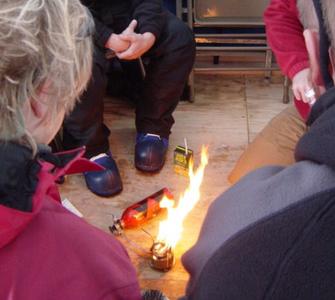
1) Is this a proper flame for our camp stove?
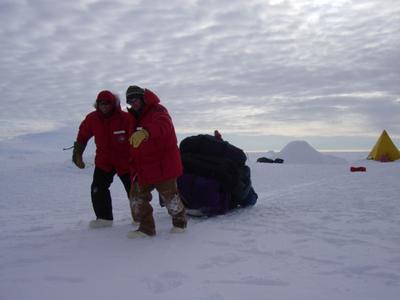
2) Hauling gear to set up camp.
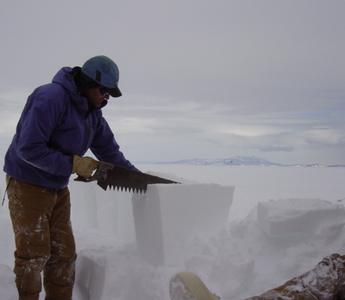
3) Our instructor Allen demonstrates how to cut snow blocks to build a roof for our shelters!
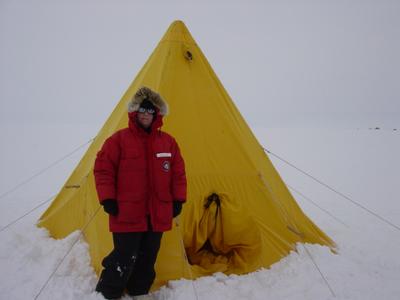
4) The traditional "Scott" tent; the most rugged tent going!
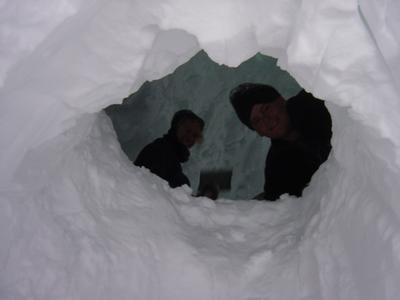
5) Rachel and Justin peer through the entrance to the Quinzee!
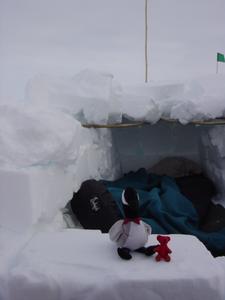
7) Home for the night; Lucy and Red prepare for a night in our Snow Trench!
Contact the TEA in the field at
.
If you cannot connect through your browser, copy the
TEA's e-mail address in the "To:" line of
your favorite e-mail package.
|
